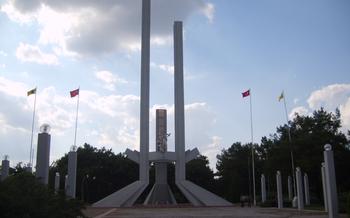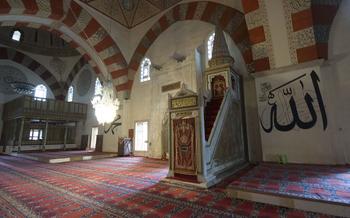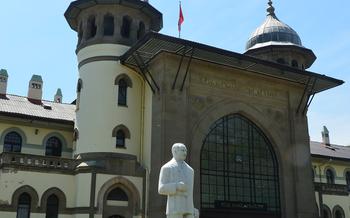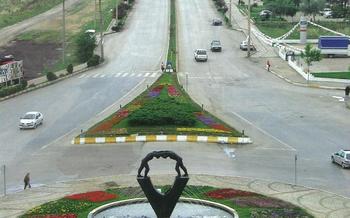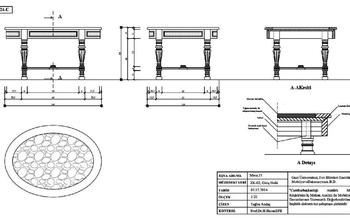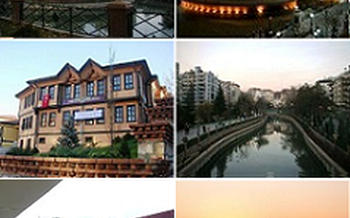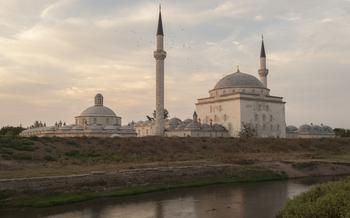
Karaağaç Atatürk Elementary School Museum
- A Symbol of Modern Turkey
- Exploring the Museum
- Educational Experience
- Atatürk's Legacy
- Historical Context
- Architectural Heritage
- Interactive Exhibits: Engaging Visitors with History
- Educational Workshops
- Research Opportunities
- Community Involvement
- Visitor Information
- Cultural Heritage
- Educational Resources
- Insider Tip: Uncover the Hidden Gem of the Karaağaç Neighborhood
A Symbol of Modern Turkey
The Karaağaç Atatürk Elementary School Museum stands as a testament to the transformative vision of Mustafa Kemal Atatürk, the founder of modern Turkey. Established in 1925 as the first educational institution founded by Atatürk, the school played a pivotal role in shaping the educational system of the newly established republic. Its architectural style reflects the blend of traditional and modern influences, making it a significant landmark in Edirne. Anecdotes abound about Atatürk's visits to the school, where he interacted with students, instilling in them the importance of education and progress. The museum preserves his legacy, showcasing personal belongings, photographs, and documents that offer a glimpse into his educational philosophy and his vision for a modern, secular Turkey.
Exploring the Museum
The Karaağaç Atatürk Elementary School Museum stands as a testament to Atatürk's vision for education and his commitment to the future of Turkey. Once the bustling classrooms where young minds were shaped, the school has now been transformed into a museum dedicated to preserving and showcasing Atatürk's legacy.
Visitors to the museum are greeted by a diverse array of exhibits and artifacts that bring history to life. Personal belongings, photographs, and documents offer a glimpse into Atatürk's life and his unwavering dedication to education. Interactive displays and multimedia presentations engage visitors, allowing them to delve deeper into the history of the school and Atatürk's educational reforms.
Guided tours led by knowledgeable guides provide visitors with a comprehensive overview of the museum's collection and Atatürk's educational vision. These tours offer a deeper understanding of the challenges faced by early educators in Turkey and the transformative impact of Atatürk's educational reforms on the nation.
Whether you are a history buff, an educator, or simply someone interested in learning more about Atatürk and his legacy, the Karaağaç Atatürk Elementary School Museum offers a rich and immersive experience that will leave you inspired and informed.
Educational Experience
The Karaağaç Atatürk Elementary School Museum is not just a place to learn about history; it is also an active center for education. The museum offers a range of educational programs and resources for students, teachers, and researchers. School groups can visit the museum and participate in guided tours that bring Atatürk's educational reforms to life. These tours are designed to help students understand the importance of education and the role it played in shaping modern Turkey.
The museum also hosts workshops and seminars on various aspects of Atatürk's educational philosophy and the history of Turkish education. These workshops provide participants with an opportunity to learn from experts in the field and to engage in discussions about the challenges and opportunities facing education in Turkey today.
The museum's educational resources include a collection of books, documents, and artifacts related to Atatürk's educational reforms. These resources are available to students, teachers, and researchers who are conducting research on Turkish education. The museum staff is also available to provide assistance to researchers and to help them access the resources they need.
One of the most popular educational programs at the museum is the "Atatürk and Education" workshop. This workshop is designed for students in grades 5-8 and focuses on Atatürk's educational philosophy and his reforms to the Turkish education system. Students learn about the importance of education in Atatürk's vision for a modern and progressive Turkey and about the challenges he faced in implementing his reforms.
The workshop also includes a visit to the museum's exhibits, where students can see artifacts from Atatürk's life and learn more about his work. The workshop is led by a trained educator who is passionate about Atatürk's legacy and who is committed to providing students with a meaningful learning experience.
Atatürk's Legacy
The Karaağaç Atatürk Elementary School Museum stands as a testament to Mustafa Kemal Atatürk's unwavering belief in the transformative power of education. Atatürk, the founder of modern Turkey, recognized that education was the key to unlocking the nation's potential and propelling it towards progress and prosperity. Through his visionary reforms, he established a modern educational system that emphasized secularism, science, and critical thinking. The museum serves as a reminder of Atatürk's legacy and his enduring commitment to education as a means of empowering individuals and shaping a progressive society.
Atatürk's educational reforms were instrumental in transforming Turkey into a modern, secular state. He believed that education should be accessible to all, regardless of gender, religion, or socioeconomic status. He introduced co-education, making it mandatory for girls to attend school, and established village schools to ensure that children in rural areas had access to education. Atatürk's reforms also focused on modernizing the curriculum, replacing religious teachings with scientific and secular subjects.
One of Atatürk's most significant educational reforms was the introduction of the Latin alphabet in 1928, replacing the Arabic script. This bold move was met with resistance from some conservative elements, but Atatürk remained steadfast in his belief that the Latin alphabet would facilitate literacy and foster a connection with the West. The adoption of the Latin alphabet allowed for the widespread dissemination of knowledge and ideas, contributing to the modernization of Turkish society.
Atatürk's educational legacy continues to shape Turkey's educational system today. His emphasis on secularism and scientific education laid the foundation for a modern, progressive society. The Karaağaç Atatürk Elementary School Museum serves as a reminder of Atatürk's vision for education and his enduring commitment to the power of knowledge.
Historical Context
The early 20th century in Turkey was a period of significant political and social transformation. The Ottoman Empire, which had ruled for over six centuries, was in decline, and the country was facing a number of challenges, including economic instability, internal strife, and foreign interference.
In this context, Mustafa Kemal Atatürk emerged as a leader who sought to modernize and reform Turkey. He believed that education was essential for progress and development, and he worked to establish a modern educational system that would prepare Turkey for the challenges of the 20th century.
One of the key challenges faced by Atatürk was the widespread illiteracy and lack of access to education in Turkey. The traditional Ottoman educational system was inadequate and did not meet the needs of a modern nation-state.
Atatürk's educational reforms aimed to address these challenges by establishing a secular, mandatory, and free education system for all Turkish citizens. He also emphasized the importance of science and technology in education, and he sought to create a new generation of educated and enlightened citizens who would help to build a modern and prosperous Turkey.
Despite the challenges, Atatürk's educational reforms were successful in transforming the educational landscape of Turkey. The establishment of the Karaağaç Atatürk Elementary School was a key part of these reforms, and it played a crucial role in shaping the educational system of modern Turkey.
Architectural Heritage
The architectural style of the Karaağaç Atatürk Elementary School Museum building is a testament to the unique blend of traditional and modern influences that characterized early 20th-century Turkish architecture. Designed by renowned Turkish architect Ali Talat Bey, the school building showcases a harmonious fusion of Ottoman and European architectural elements. The imposing stone façade, with its grand entrance and symmetrical layout, evokes a sense of grandeur and stability, while the ornate details and decorative tilework pay homage to Turkey's rich cultural heritage.
The school's spacious and well-lit interiors are a testament to Atatürk's emphasis on creating a conducive learning environment. Large windows flood the classrooms with natural light, while high ceilings and airy corridors create a sense of openness and freedom. The building's sturdy construction, using high-quality materials and innovative techniques, ensured its longevity, allowing it to withstand the test of time and remain a prominent landmark in Edirne.
Preservation and restoration efforts have been meticulously undertaken to maintain the school's historical integrity. Original features, such as the intricate tilework, ornate plaster moldings, and wooden paneling, have been carefully restored, ensuring that the building retains its original charm and character. The school's transformation into a museum has been carried out with great sensitivity, respecting the building's architectural heritage while creating a space that is both educational and inspiring.
Interactive Exhibits: Engaging Visitors with History
The Karaağaç Atatürk Elementary School Museum is not just a repository of historical artifacts; it is an interactive space that brings history to life for visitors of all ages. Through a variety of interactive displays and multimedia presentations, the museum engages visitors and helps them understand Atatürk's legacy in a more immersive and memorable way.
One of the most popular interactive exhibits is a virtual reality experience that allows visitors to step back in time and experience what it was like to be a student at the school during Atatürk's time. Visitors can explore the classrooms, interact with virtual teachers and students, and learn about the educational methods and curriculum of the early 20th century.
Another highlight of the museum is a multimedia presentation that tells the story of Atatürk's educational vision and his efforts to establish a modern educational system in Turkey. The presentation features historical footage, photographs, and audio recordings, as well as interactive quizzes and activities that test visitors' knowledge of Atatürk's educational reforms.
These interactive exhibits are not just entertaining; they are also educational. They help visitors to understand the historical context of Atatürk's reforms, the challenges he faced, and the impact of his vision on Turkish education and society. By making history accessible and interactive, the Karaağaç Atatürk Elementary School Museum is ensuring that Atatürk's legacy continues to inspire and educate future generations.
Educational Workshops
The Karaağaç Atatürk Elementary School Museum offers a range of educational workshops and seminars to promote Atatürk's ideas on education and social progress. These workshops are designed to engage students, teachers, and researchers in interactive learning experiences that explore the historical and contemporary significance of Atatürk's educational reforms.
One popular workshop focuses on Atatürk's educational philosophy, examining his belief in the power of education to transform society and the importance of critical thinking and scientific inquiry. Participants engage in discussions, activities, and role-playing exercises to understand Atatürk's vision for a modern and progressive educational system.
Another workshop delves into the history of Turkish education, tracing its evolution from the Ottoman era to the present day. Participants learn about the challenges faced by early educators in Turkey, the establishment of the modern education system, and the impact of Atatürk's reforms on the country's educational landscape.
The museum also offers specialized workshops for teachers, providing them with practical tools and strategies to incorporate Atatürk's educational principles into their teaching practices. These workshops cover topics such as inquiry-based learning, student-centered education, and the use of technology in the classroom.
By participating in these workshops, visitors gain a deeper understanding of Atatürk's educational legacy and its relevance to contemporary education. The interactive format and engaging activities make these workshops a valuable learning experience for participants of all levels.
Research Opportunities
The Karaağaç Atatürk Elementary School Museum is not only a place to learn about Atatürk's legacy and Turkish education but also a hub for research and scholarship. The museum houses a wealth of archival materials, including documents, photographs, and artifacts related to Atatürk's educational reforms and the history of Turkish education. These materials are available to researchers and scholars who wish to study these topics in depth.
The museum staff is dedicated to supporting researchers in their work. They provide access to the archival materials, assist with research inquiries, and offer guidance on research methodologies. The museum also hosts regular seminars and workshops on topics related to Atatürk's legacy and Turkish education, providing a platform for researchers to share their findings and engage in scholarly discussions.
One researcher who benefited from the museum's resources is Dr. Ayşe Özkul, a professor of education at Ankara University. She used the museum's archives to research Atatürk's educational reforms and their impact on the development of modern Turkey. Her research resulted in a book that is now considered a standard reference on the topic.
"The Karaağaç Atatürk Elementary School Museum is a treasure trove for researchers studying Atatürk's legacy and Turkish education," said Dr. Özkul. "The museum staff was incredibly helpful and supportive, and the archival materials were invaluable to my research. I am grateful for the opportunity to have conducted my research at the museum."
The museum's research facilities are open to scholars from all over the world. Researchers can apply for access to the archival materials by contacting the museum staff. The museum also offers research grants to support scholars who are conducting research on topics related to Atatürk's legacy and Turkish education.
Community Involvement
The Karaağaç Atatürk Elementary School Museum actively engages with the local community through various educational programs and events. These initiatives aim to promote cultural heritage, foster social cohesion, and make the museum accessible to a diverse audience. The museum organizes history workshops, storytelling sessions, and art exhibitions that explore Atatürk's legacy and the history of Turkish education. These events provide a platform for community members to share their stories, learn from experts, and engage in meaningful discussions. The museum also collaborates with local schools, inviting students for guided tours and interactive workshops on Atatürk's educational philosophy. Through these initiatives, the museum strives to create a sense of ownership and belonging among the community members, fostering a deeper appreciation for their cultural heritage and Atatürk's vision for a progressive and enlightened society.
Anecdote:
During a community event at the museum, a group of elderly residents shared their fond memories of attending the Karaağaç Atatürk Elementary School in their youth. They recalled the inspiring speeches and interactions with Atatürk during his visits to the school, which instilled in them a lifelong commitment to education and social progress. These personal anecdotes brought history to life for the younger generation, showcasing the profound impact of Atatürk's educational legacy on individuals and the community as a whole.
Visitor Information
The Karaağaç Atatürk Elementary School Museum is located in the city of Edirne, Turkey. It is open to the public from Tuesday to Sunday, from 9:00 AM to 5:00 PM. Admission to the museum is free of charge. The museum is wheelchair accessible, with ramps and elevators available for visitors with disabilities.
To make the most of your visit, plan your itinerary carefully. Allow at least two hours to explore the museum's exhibits and learn about Atatürk's legacy. If you are short on time, focus on the highlights, such as the personal belongings and photographs of Atatürk. If you have more time, take advantage of the guided tours offered by the museum. These tours provide a deeper insight into the history of the school and Atatürk's educational vision.
After visiting the museum, take some time to explore the surrounding area. The museum is located in the historic city center of Edirne, which is home to many other historical and cultural attractions. Be sure to visit the Selimiye Mosque, the Edirne Palace, and the Balkan Museum.
One insider tip for visitors is to visit the museum on a weekday to avoid the crowds. The museum is most crowded on weekends and during school holidays. If you are visiting during the summer months, be sure to bring a hat and sunscreen, as the weather in Edirne can be quite hot and sunny.
Cultural Heritage
The Karaağaç Atatürk Elementary School Museum holds a significant place in Turkey's cultural heritage. It stands as a testament to the country's rich history and the educational reforms initiated by Mustafa Kemal Atatürk. The school's transformation into a museum has ensured the preservation of its historical and architectural value, allowing it to serve as a valuable cultural asset for generations to come.
The museum's exhibits and artifacts provide a glimpse into the cultural context of early 20th-century Turkey and the challenges faced by educators during that period. Visitors can learn about the unique educational philosophy espoused by Atatürk, which emphasized the importance of secularism, modernism, and scientific thinking. The museum also sheds light on the broader cultural transformation that took place in Turkey during the early Republican era, as the country transitioned from a traditional society to a modern nation-state.
The Karaağaç Atatürk Elementary School Museum serves as a reminder of the importance of education and its role in shaping a nation's cultural identity. By preserving and promoting the legacy of Atatürk's educational reforms, the museum contributes to the preservation of Turkish cultural heritage and provides a valuable resource for understanding the country's rich history.
Educational Resources
The Karaağaç Atatürk Elementary School Museum houses a wealth of educational resources that are available to students, teachers, and researchers. These resources include a collection of books, documents, and artifacts related to Atatürk's educational reforms and the history of Turkish education. The museum also provides access to a research library and archives, where visitors can conduct research and learn more about Atatürk's legacy.
One of the most valuable resources at the museum is the collection of Atatürk's personal belongings. These items, which include his clothing, furniture, and books, provide a glimpse into Atatürk's life and work. Visitors can also view a collection of photographs and documents that document Atatürk's visits to the school and his interactions with the students.
The museum's educational resources are not only valuable for researchers, but also for students of all ages. The museum offers a variety of educational programs and workshops that are designed to teach students about Atatürk's educational reforms and the history of Turkish education. These programs are led by experienced educators who use interactive activities and multimedia presentations to bring history to life.
Anecdote:
A group of students from a local high school visited the museum on a field trip. They were particularly interested in learning about Atatürk's educational reforms. The museum's educator led them on a tour of the museum, where they saw Atatürk's personal belongings and learned about his vision for education. The students were so inspired by the visit that they decided to start a club at their school to promote Atatürk's ideas on education.
Insider Tip: Uncover the Hidden Gem of the Karaağaç Neighborhood
Beyond the walls of the Karaağaç Atatürk Elementary School Museum, the charming neighborhood of Karaağaç awaits exploration. Take a leisurely stroll along its cobblestone streets and discover hidden gems like the cozy cafes, artisan shops, and traditional Turkish restaurants. Immerse yourself in the local culture by savoring the flavors of Turkish cuisine, indulging in the art of Turkish coffee, and engaging with the friendly locals. As you wander through the neighborhood, keep an eye out for the beautiful murals that adorn the walls, showcasing scenes from Edirne's rich history and culture. Don't miss the opportunity to visit the bustling local market, where you can find fresh produce, handmade crafts, and souvenirs to cherish your memories of Edirne.
